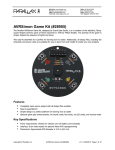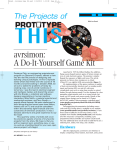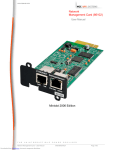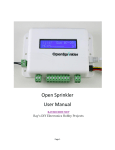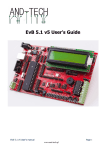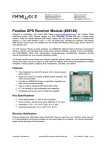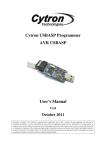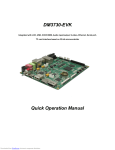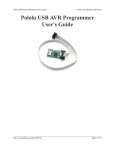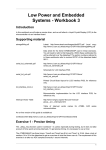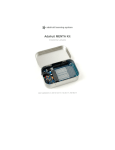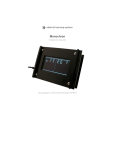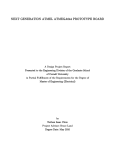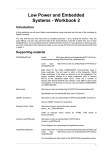Download AVRSimon Game Kit (#28905)
Transcript
Web Site: www.parallax.com Forums: forums.parallax.com Sales: [email protected] Technical: [email protected] Office: (916) 624-8333 Fax: (916) 624-8003 Sales: (888) 512-1024 Tech Support: (888) 997-8267 AVRSimon Game Kit (#28905) The Parallax AVRSimon Game Kit, designed by Grand Idea Studio, is a re-creation of the addictive, flyingsaucer-shaped memory game of Simon launched in 1978 by Milton Bradley. The premise of the game is simple: Repeat the sequence of lights and tones. This easy-to-assemble kit is perfect for learning how to solder. Additionally, all design files, including the schematic and source code, are available for you to learn from and modify to create your own projects. Features y y y y Completely open-source project with all design files available Easy-to-assemble kit Simple design is a perfect platform for learning how to solder Optional game play enhancements: No sound mode, fast mode, no LED mode, and reverse mode Key Specifications y y y Power requirements: CR2032 3V Lithium coin cell battery (not included) Interface: 6-pin male header for optional Atmel AVR reprogramming Dimensions: Approximate PCB diameter is 3.25 in (8.5 cm) Copyright © Parallax Inc. Downloaded from Elcodis.com electronic components distributor AVRSimon Game Kit (#28905) v1.0 3/22/2010 Page 1 of 10 Bill of Materials Verify that your AVRSimon Game Kit is complete in accordance with the list below, and gather the additional items needed. Designator Quantity R1 R5 R2 R3, R4, R6 C1 1 1 1 3 1 1 1 1 1 1 1 4 1 1 1 1 1 D3 D1 D4 D2 SW5 SW1-SW4 U1 P1 U1 BT1 LS1 Description Part # Resistor, 1 kΩ (brown, black, red) Resistor, 10 kΩ (brown, black, orange) Resistor, 3.3 kΩ (orange, orange, red) Resistor, 330 Ω (orange, orange, brown) Capacitor, ceramic, 0.1uF AVRSimon PCB LED, Green LED, Red LED, Yellow LED, Blue SPDT slide switch, 2mm SPST pushbutton Socket, DIP20 Header, 3 x 2 vertical, male AVR Microcontroller, pre-programmed Battery holder,CR2032 Lithium Piezoelectric Buzzer 150-01020 150-01030 150-03314 150-03315 211-01011 300-28905 350-00001 350-00006 350-00007 350-00030 400-00026 400-00030 450-02020 451-00602 604-28905 753-00004 900-00017 Additional items needed y y y Soldering iron Solder Eye protection Copyright © Parallax Inc. Downloaded from Elcodis.com electronic components distributor y y Wire snips CR2032 3V Lithium coin cell battery AVRSimon Game Kit (#28905) v1.0 3/22/2010 Page 2 of 10 Assembly Instructions Assembly of the AVRSimon kit should take about 15 to 30 minutes. The recommended assembly order is as follows, starting with the lowest profile (shortest) components and building up from there: R1-R6, C1, SW1-SW5, D1-D4, LS1, U1, BT1. For quick reference, this list is also printed on the back of the AVRSimon circuit board. Most of the parts are non-polarized, meaning they can be inserted into the circuit board in any orientation and still function normally. The only exceptions are the microcontroller U1, LEDs D1-D4, and battery holder BT1, and care must be taken to ensure these components are inserted properly to avoid potential damage to AVRSimon. Step 1: Begin by inserting and soldering the resistors R1R6 and capacitor C1. After clipping the leads, insert and solder the four pushbuttons SW1-SW4 and power switch SW5. The four pushbuttons will “snap” into the circuit board when they are properly pushed all the way in. Step 2: Next, insert and solder the four LEDs, colored red, blue, green, and yellow, denoted by D1-D4, respectively. LEDs are polarized and must be inserted in the proper orientation in order for them to work. The flat edge of the plastic LED casing designates the cathode (sometimes a notch is used instead) and should be lined up with the flat side of the LED outline printed on the circuit board. Then, insert and solder the piezo buzzer LS1. Orientation is not crucial, but for aesthetic reasons you may want to place it so the logo printed on it appears right-side up. Copyright © Parallax Inc. Downloaded from Elcodis.com electronic components distributor AVRSimon Game Kit (#28905) v1.0 3/22/2010 Page 3 of 10 Step 3: Now, insert and solder U1’s 20-pin socket. A handy tip is to place a piece of Scotch tape over the socket once it has been inserted into the PCB to prevent it from falling out when you flip the board over to solder. This part is the trickiest for beginners, as the pins are spaced close together, so be careful not to create any “solder bridges” between pins. Once the socket is soldered into place, remove the tape if you used any and align U1 so the notch on its plastic packaging is facing to the left (so pin 1 is at the lower-left corner of the socket). Gently but firmly press U1 into the socket, ensuring that all the pins are seated properly within the socket and none of the leads have accidentally bent outwards. Step 4: Finally, flip the circuit board over and solder the BT1 battery holder, the only surface mount part in the kit, onto the backside of the board. Pay close attention to the positive (“+”) and negative (“-”) markings on the plastic part of the holder and align the positive side with the “+” marking on the circuit board. Step 5: With the kit assembly complete, the last step is to insert the CR2032 Lithium coin cell battery into the holder. Slide the edge of the battery towards the “+” side of the battery holder and underneath the two gold “teeth.” Then, press firmly down on the other edge of the battery until it snaps into place within the holder. Copyright © Parallax Inc. Downloaded from Elcodis.com electronic components distributor AVRSimon Game Kit (#28905) v1.0 3/22/2010 Page 4 of 10 How to Play In a nutshell, AVRSimon gameplay is as follows: y y y y Turn On Play Game Memorize and Repeat Pattern Score Given When Game Over When you first power on the game, a start-up tune will welcome you. Press any of the pushbuttons to start playing. The game will generate a sequence of lights/sounds that you are to repeat, first starting with a single element. After the sequence has been presented, simply press the button(s) corresponding to the LED that was illuminated and repeat the pattern. The sequence length will increment each time you successfully repeat the pattern, making the game increasingly more difficult as you go. The maximum sequence length is 255. When your game is over, a short tune will be played, the correct LED in the sequence that you were supposed to enter will be illuminated, and then your score will be given by a series of blinking LEDs. The green LED corresponds to ‘hundred,’ the red LED to ‘ten,’ and the blue LED to ‘one.’ For example, if you failed after a thirteen element sequence, the red LED will first blink once and then the blue LED will blink three times. AVRSimon has a few optional twists to make gameplay more fun and interesting for advanced players. These special modes are selected by holding down one the pushbuttons SW1-SW4 while first turning on the game (multiple pushbuttons can be held down at one time to create various combinations): SW1: No Sound/Quiet mode No sounds are generated while in this mode, making it perfect for gameplay while late at night, in a library, conference session, or classroom. SW2: Fast mode This mode increases the speed of which the LED sequence is played by three times and reduces the length of time allowed for you to repeat the sequence. Normally, you have five seconds to make a decision for each move. In fast mode, you’re only allowed two. SW3: No LED mode No LEDs are illuminated while in this mode. You’ll have to repeat the pattern based on sound alone. SW4: Reverse move This mode operates like a FIFO (First In, First Out) stack in which you have to replay the sequence in reverse order (instead of repeating the exact order that the game presents). To revert back to game’s normal mode of operation, simply power cycle the unit. Copyright © Parallax Inc. Downloaded from Elcodis.com electronic components distributor AVRSimon Game Kit (#28905) v1.0 3/22/2010 Page 5 of 10 How it Works Hardware The schematic is available from the AVRsimon product page; search “28905” at www.parallax.com. Like the original game of Simon, AVRSimon’s user interface is simple, comprising four buttons, four LEDs, and a buzzer for playing sounds. AVRSimon runs on an Atmel ATtiny2313V, an 8-bit AVR microcontroller. One side of each button (SW1, SW2, SW3, SW4) is connected to Port B 1, 4, 0, and 3, respectively. The other side of the buttons are connected to ground. The internal pull-up resistor (with a value between 20 kΩ and 50 kΩ, according to the ATtiny2313V data sheet) is enabled on each of the Port B pins, removing the need for four external resistors. The buttons are active low, so the microprocessor normally sees a high signal (‘1’), due to the pull-up resistor, when the button isn’t being pressed. When a button is pressed, the microprocessor sees a low signal (‘0’). The cathodes of the four LEDs, matching the four colors of the original Simon game (D1 red, D2, blue, D3 green, D4 yellow), are connected to Port D 0, 3, 1, and 2, respectively. A current limiting resistor (R1, R3, R4, R2) connected to VCC is used in series with each LED to limit the amount of current allowed to flow through the LED, which sets the brightness and prevents excessive current from damaging the LED. Like the buttons, the LEDs are active low and set up in a current sink configuration, meaning they will turn on when the output signal on one of the Port D pins is low (‘0’). When we want to turn an LED off, we simply set the corresponding pin’s output value to high (‘1’). Each port pin on the ATtiny2313V can safely sink 20 mA, which is well above what the LEDs on AVRSimon require - when the red LED is on, it requires 1.3 mA, the green 3.0 mA, blue 0.13 mA, and yellow 3.2 mA. One side of the piezo buzzer, LS1, is connected to ground and the other side is connected to Port B 2 via R6, a current-limiting resistor. Instead of using the general purpose I/O function as with the button inputs and LEDs, Port B 2 is used as its special function, Output Compare for Timer 0, which output waveforms that will drive the piezo buzzer. Turning the game on and off is achieved with a simple slide switch used in an SPST configuration that connects and disconnects the battery supply from the VCC bus of the circuitry. The system is powered with a single CR2032 3V Lithium coin cell, which is easy to obtain from any local drugstore, convenience store, or electronics outlet. The CR2032 has a very nice current capacity for its size (20mm in diameter) of approximately 225 mAh, although the lithium battery chemistry works best for applications requiring very low current discharge over months or years of use. Its maximum recommended continuous discharge is 3 mA, which is what AVRSimon draws during gameplay. When the game is not being used and while the system is waiting for a button press to begin a new game, U1 is placed into a sleep mode and current consumption is reduced to a scant 19.5uA. With typical gameplay of a few hours a day, a single battery should last more than a month. There are a few other discrete components used in this design: C1 is a standard bypass/decoupling capacitor connected close to the VCC input of U1. R5 is a pull-up resistor connected to the active-low /RESET line of U1 that keeps the microcontroller operating properly (e.g., not resetting) unless the pin is intentionally pulled low, which will only be done if you take advantage of the AVR In-System Programming (ISP) functionality. P1 is the standard 6-pin AVR ISP header. This is an optional part that is only required if you plan on making changes to the firmware and want to reprogram U1 while it is incircuit. Copyright © Parallax Inc. Downloaded from Elcodis.com electronic components distributor AVRSimon Game Kit (#28905) v1.0 3/22/2010 Page 6 of 10 Firmware AVRSimon combines a number of basic microcontroller functions, such as reading switch inputs and turning LEDs on and off, with more complicated ones, such as using sleep modes to extend battery life and playing sounds, which makes it a great platform to learn about microcontrollers and embedded programming. From the highest level view, the operation of the AVRSimon firmware is straightforward. Upon power-up, the hardware is initialized within the aptly named hardware_init() function, which brings the system into a known state. The function configures the I/O pins (LED pins as outputs, switch pins as inputs), sets up the timers (Timer 0 is used for tone generation and Timer 1 for timeout counting used during gameplay), and enables the Pin Change Interrupt. Then, simon_config() is called, which sets the gameplay mode based on the combination of pushbuttons SW1-SW4 held down during power-up. If no buttons are pressed during power-up, then the game will play in the normal mode. Other modes include no sound mode, fast mode, no LED mode, and reverse mode, and serve as an additional challenge for advanced users. Details of each special mode are discussed in the How to Play section. After all configuration is complete, we move into the core simon_game() routine. Immediately after entering simon_game(), the system is configured to enter a low-power sleep mode and to awake on a button press from any of the four buttons. Sleep mode is attained by calling a specific sequence of functions/macros, which define the type of sleep mode we want to enter, configuring the interrupts, and then going to sleep: // prepare to go to sleep/idle mode... set_sleep_mode(SLEEP_MODE_PWR_DOWN); cli(); sleep_enable(); sei(); sleep_cpu(); // go to sleep here to save power Sleep mode conserves a significant amount of power by shutting down all unused modules of the microcontroller and only keeping the absolute essential features awake. In our selected Power-Down Mode (SLEEP_MODE_PWR_DOWN), all clocks and oscillators are disabled, all peripheral modules are turned off, and the only ways to awaken the device are via specific resets (external, watchdog, or brown out), serial interface or INT0 external interrupts, or a Pin Change Interrupt generated on specific port pins when the level changes from low to high or high to low. Fore more details of sleep mode implementations, see http://www.nongnu.org/avr-libc/user-manual/group__avr__sleep.html. With AVRSimon, when a button press is detected via the Pin Change Interrupt on Port B 0, 1, 3, or 4 (corresponding to SW3, SW1, SW4, SW2, respectively) the system springs to life and begins the game. Copyright © Parallax Inc. Downloaded from Elcodis.com electronic components distributor AVRSimon Game Kit (#28905) v1.0 3/22/2010 Page 7 of 10 The game itself is comprised of two core functions, simon_play_moves() and simon_read_moves(): simon_play_moves() first pulls a number from rand(), a linear feedback shift register used as a pseudo-random number generator (http://en.wikipedia.org/wiki/PRNG), which is seeded at the beginning of each game with the current value of the Timer 1 counter and whatever pushbutton was pushed to start the game, and limits the result from ‘0’ to ‘3’ (corresponding to one of the four possible LED colors on AVRSimon). The number is then stored in U1’s internal EEPROM (Electrically Erasable Programmable Read-Only Memory), a non-volatile storage container with individual byte addressing, at the memory address equal to the current length of the sequence. The game then plays the entire sequence that is currently in its EEPROM, contiguously from address 0 until the end of the sequence is reached. For more details on EEPROM handling, see the web address at the bottom of this page. The game then enters the simon_read_moves() routine, which waits for the player to begin replaying the sequence. For each move in the sequence, the corresponding address of the EEPROM is read and compared with the player’s input. If the values do not match, then the player must have pushed the wrong button and the game will end via the simon_failed_input() function. If the values do match, then the player pushed the correct button and the game proceeds to the next move in the sequence. If the player successfully repeats the entire sequence, the game jumps back to simon_play_moves() to add another move to the sequence and repeat the process until the game is over. http://www.nongnu.org/avr-libc/user-manual/group__avr__eeprom.html Copyright © Parallax Inc. Downloaded from Elcodis.com electronic components distributor AVRSimon Game Kit (#28905) v1.0 3/22/2010 Page 8 of 10 Sound Tone generation is based on the xyloduino project: http://www.rocketnumbernine.com/2009/03/27/xyloduino-simple-arduinopiezo-organ/ ...and modified to support arrays of octaves, notes, and durations in order to create melodies. Timer 0, a hardware peripheral internal to U1, is used as an 8-bit counter that will toggle the OC0A output pin (Port B pin 2) from low to high or high to low when the counter value (TCNT0) matches the value programmed into the Output Compare Register (OCR0A). The toggling of the output pin will generate a square wave at the desired frequency that is fed into the piezo buzzer LS1. The play_note() routine is passed the octave, note, and length of the sound. It configures the Timer/Counter Control Register (TCCR0B) and OCR0A accordingly, waits for the sound to be played, and then disables the counter: if (note) { TCCR0B = pre[(int)octave]; // set the prescaler depending on what octave is selected OCR0A = note >> (octave%2); // there are two octaves for each prescale setting, so adjust accordingly } delay_ms(length); // play sound for specified length TCCR0B = 0; // turn off sound In order to play a melody (comprising a sequence of notes stored in an array), the routine is called one time for each note: for (i = 0; i < STARTGAME_SND_SIZE * 4; i = i + 4) { // octave, note, length play_note(pgm_read_byte(startgame_snd_p + i), pgm_read_byte(startgame_snd_p + i + 1), pgm_read_word(startgame_snd_p + i + 2)); delay_ms(50); // pause in between notes } The four sounds generated on the original Simon were based on four primary notes of a bugle, which sound “in tune” when played in any order. AVRSimon closely mimic those notes: http://www.waitingforfriday.com/index.php/Reverse_engineering_an_MB_Electronic_Simon_game Tone Tone Tone Tone 1: 2: 3: 4: Blue, 392 Hz (G note) Yellow, 330 Hz (E note) Red, 262 Hz (C note) Green, 196 Hz (G note) Copyright © Parallax Inc. Downloaded from Elcodis.com electronic components distributor AVRSimon Game Kit (#28905) v1.0 3/22/2010 Page 9 of 10 Development Environment AVRSimon was developed on OS X using CrossPack for AVR: http://www.obdev.at/products/crosspack/download-de.html Formerly known as AVR MacPack, the package contains the core compiler, debugger, and AVR-specific tools and integrates seamlessly with Apple’s Xcode. In-circuit device programming was achieved using an adafruit industries USBtinyISP interface: http://www.adafruit.com/index.php?main_page=product_info&cPath=16&products_id=46 If you choose to modify AVRSimon’s firmware, you’ll need to recompile the code and then reprogram it into the microcontroller. To reprogram, hook up the USBtinyISP to P1 (insert and solder this optional 6pin male header onto AVRSimon if you haven’t done so already), locating pin 1 by its square pad on the backside of the circuit board (as opposed to the other pads on the connector which are circular). Then, open a Terminal window and go to your /firmware/ directory. Finally, run the make install command, which launches the avrdude application twice with different parameters - once to load the compiled binary into Flash memory and once to set the device’s configuration fuses (set in the Makefile): 1) avrdude -c usbtiny -p attiny2313 -U flash:w:main.hex:i 2) avrdude -c usbtiny -p attiny2313 -U hfuse:w:0xd1:m -U lfuse:w:0xe4:m For more information on Atmel AVR development, see: • • AVR Freaks web page: http://www.avrfreaks.net/ adafruit industries’ AVR Tutorial web page: http://www.ladyada.net/learn/avr/ Additional Resources • • • Grand Idea Studio’s AVRSimon web page: www.grandideastudio.com/portfolio/AVRSimon/ Simon (game), Wikipedia entry, http://en.wikipedia.org/wiki/Simon_(game) U.S. Patent #4,207,087, Microcomputer controlled game (the original Simon patent): www.google.com/patents/about?id=MAIyAAAAEBAJ&dq=4207087 Copyright © Parallax Inc. Downloaded from Elcodis.com electronic components distributor AVRSimon Game Kit (#28905) v1.0 3/22/2010 Page 10 of 10










